Scenario as Advantage: Standardization of AI Empowers Industries
2025-11-13
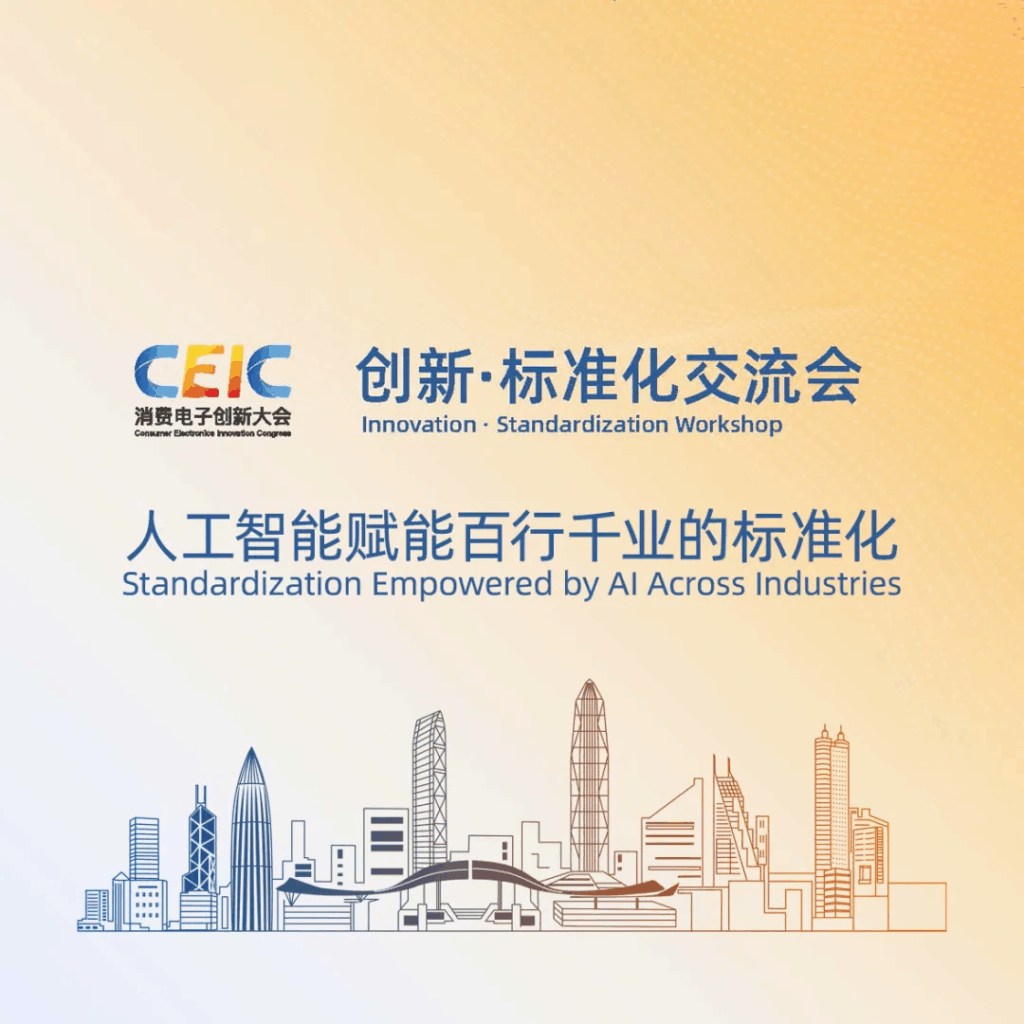

Meeting Metadata
Title: 2025 CEIC Innovation & Standardization Workshop — “Standardization Empowered by AI Across Industries” Roundtable
Date: November 7, 2025
Location: Peony Hall, Shenzhen Futian International Convention and Exhibition Center, China
Organizers: 2025 Consumer Electronics Innovation Congress (CEIC) Committee, Comentropy Industry and Standards Innovation Service Center
Supporter: China National Institute of Standardization (CNIS)
Participants: Over 200 experts, academics, and industry leaders from China and beyond
Moderator:
- Li Li | Chief Standards Scientist, Huawei Technologies Co., Ltd.
Panelists:
- Gan Keqin | Deputy Director, Advanced Technology Standardization Institute, China National Institute of Standardization
- Chen Xi | Standards Director, Shanghai Artificial Intelligence Research Institute
- Liao Fangli | Director of Tencent Strategic Communication Center
- Shen Zhiyue | Senior Engineer, China Electronics Standardization Institute
- Yang Tao | Vice Chairman, Comentropy Industry and Standards Innovation Service Center
Roundtable Summary

The roundtable was convened during a critical moment for global AI standardization. According to Stanford’s 2025 AI Index Report, the demand for computing power has surged. Concurrently, the ISO/IEC/ITU held the inaugural International AI Standards Summit, and innovations like China’s DeepSeek have reshaped the competitive landscape. The discussion centered on the highly complex topic of “Standardization Empowered by AI Across Industries,” with six experts from academia, industry, and government contributing their insights.
Key Findings

1 Strategic Differences: Global AI development follows three distinct paths: United States: Capital-driven. Europe: Governance-prioritized. China: Scenario-driven. Standardization strategies must align with these differing value orientations.
2 Application-First Principle: China’s AI standardization should focus on its unique advantage of diverse application scenarios, avoiding the U.S.-style “heavy-asset trap,” and derive standards from the practical needs of industries.
3 Breakthrough Areas: Standardizing embodied intelligence faces challenges in dynamic stability, dexterous manipulation, and high-quality datasets. China is actively contributing its solutions in international organizations like ISO.
4 Ethical Consensus: The replacement of human labor is the most pressing AI ethics issue. Experts argue that AI promotes the evolution of work rather than simple unemployment, necessitating top-level design to accompany changes in production relationships.
5 International Cooperation: Standards serve as an effective tool to break geopolitical barriers. Communication within the AI technical standards domain remains smooth, and international standard mutual recognition should be boldly pursued.
6 Next-Generation Infrastructure: Agent-to-Agent communication protocols (A2A/MCP) represent a strategic high ground. China must address the overlooked “identity recognition” gap to avoid repeating the passive situation with internet protocols.
7 Urgency of Pre-Standardization Research: Technical breakthroughs must be accompanied by pre-standardization efforts; otherwise, even with technical leadership, dominance in ecosystems and markets may be lost.
Expert Consensus
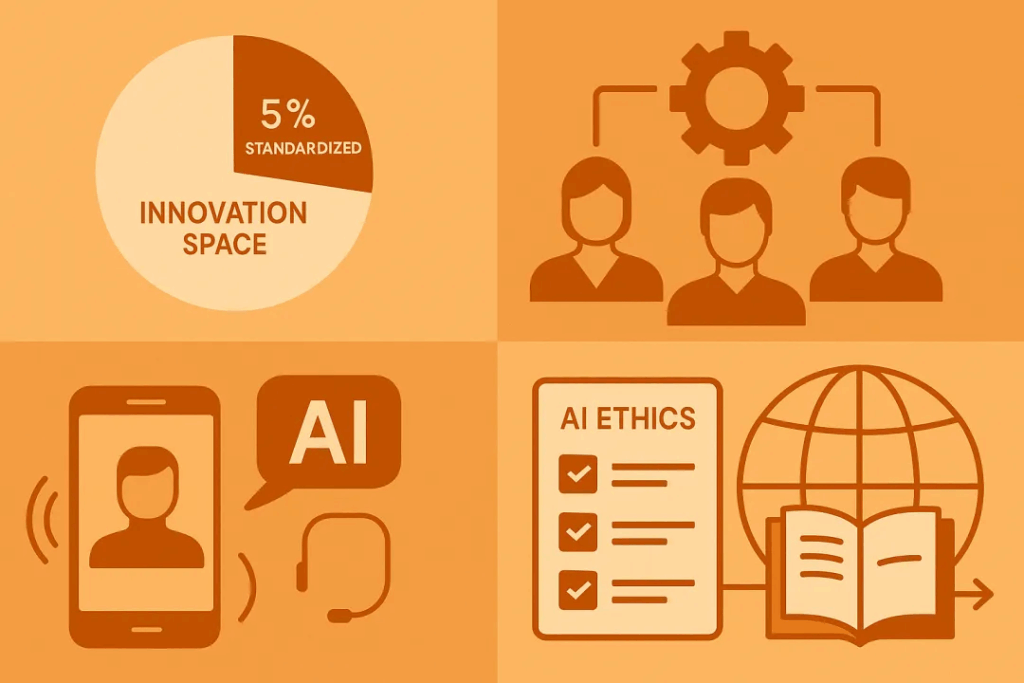
- Only 5% of areas truly require standardization, while 95% should preserve room for innovation.
- A national-level, cross-ministerial AI standardization coordination mechanism is essential.
- Accelerating the development of Chinese standards for intelligent agent communication is crucial to overcoming identity recognition bottlenecks.
- Transforming AI ethics discussions into quantifiable and product-embeddable technical standards is necessary.
- Expanding the publication of standards in foreign languages will position standards as a bridge for technological diplomacy and industry globalization.
1. Analysis of the Global AI Standardization Landscape

1.1 Strategic Comparison of Three Development Paths
Li Li, drawing upon his extensive experience in Europe, revealed three typical paths for global AI development:
United States: Capital-Driven + Frontier Breakthroughs
- Focuses on AGI (Artificial General Intelligence) and ASI (Artificial Superintelligence).
- Claims to control 40% of the global computing power market through the “Stargate” project.
- Development is centered on capital, with capitalists dictating the direction of progress.
- Strategic Weakness: Over-reliance on heavy asset investments and restricting competitors, which results in structural fragility.
Europe: Governance-Prioritized + Cautious Progress
- Took the lead in introducing the AI Act, imposing strict regulations on high-risk AI.
- Developing foundational infrastructure such as “AI Superfactories.”
- Application Dilemma: Practical applications remain extremely conservative due to concerns over labor union backlash and unemployment issues.
China: Scenario-Driven + Scaled Applications
- Focuses almost entirely on the application layer.
- The diverse needs of 1.4 billion people create the world’s most abundant application scenarios.
- Rapidly advancing AI empowerment across thousands of industries and sectors.
Liao Fangli (Tencent):
“China’s most unique advantage in AI development lies in its incredibly diverse scenarios. Whether it’s B2B industrial applications or B2C scenarios like work, education, and entertainment, this is something neither the U.S.’s computing power advantage nor Europe’s governance advantage can match.”
1.2 Strategic Positioning for China’s AI Standardization
Expert Consensus: China’s AI standardization must serve the goal of scenario-driven large-scale applications. It should avoid being misled by the heavy-asset investments of the U.S. or the overregulation of Europe.
Li Li (Huawei):
“The U.S. strategy has two flaws: 1. It revolves around capital and heavy-asset investments; 2. It develops by restricting competitors. Real AI don’t necessarily require heavy assets or AGI. A simple AI tailored to specific scenarios can solve practical problems.”
2. Standardization Practices in Core Technical Domains
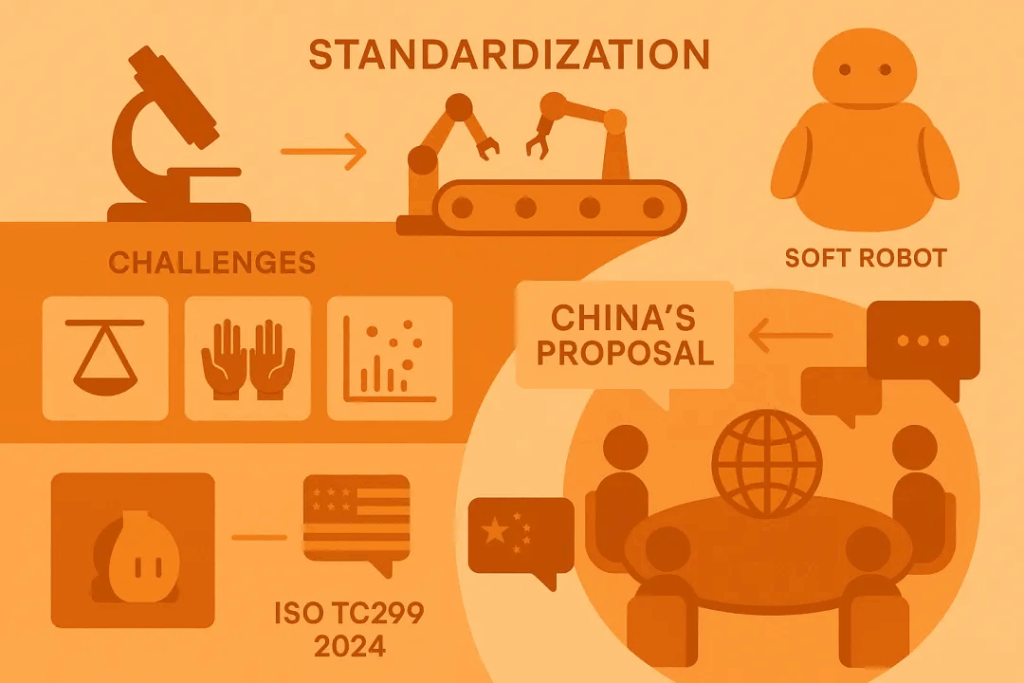
2.1 Embodied Intelligence: Bridging the “Last Centimeter” from Lab to Factory
Chen Xi from the Shanghai Artificial Intelligence Research Institute shared insights from their work in ISO TC299 (International Robotics Standards Committee), identifying three core challenges in embodied intelligence standardization:
Challenge 1:Dynamic Stability & Safety Assurance:
Problem: How can embodied intelligence handle instability, component failures, and unpredictability in unstructured environments?
China’s Solution: Within ISO TC299 WG12 (Working Group on Safety Requirements for Dynamic Stability of Industrial Mobile Robots), Chinese experts proposed unique safety requirements for the dynamic stability of bipedal humanoid robots, including: Upper and Lower Limb Coordination Safety, Interaction Collision Safety, Component Failure Safety. These measures are designed to prevent harm to both the robots themselves and their surrounding environments.
International Response: Experts from the United States, South Korea, and Europe have expressed their agreement with and support for China’s proposals, welcoming continuous contributions from Chinese researchers.
Chen Xi (Shanghai AI Research Institute):
Embodied intelligence must not only meet traditional robotic safety standards—such as mechanical safety, electrical safety, and functional safety—but also address risk prevention for instability, firmware failures, and close human-robot interactions in uncontrollable environments.
Challenge 2: Dexterous Hand Precision in Fine Operations
Strategic Significance: Just as human civilization’s progress depends on hands for tool use, the final “one centimeter” that enables embodied intelligence to “get the job done” lies in the precision operation capabilities of dexterous hands.
Standard Achievements: The Shanghai AI Research Institute is leading the development of China’s first industry standards for dexterous hand technical specifications, which define:
- Classification System: Categories such as bionic designs and linkage-based designs.
- Core Technical Indicators: Metrics including fingertip force, finger pad force, joint velocity/angle, and positioning accuracy.
- Standard Testing Methods: Specifications for dimensions and material definitions of standard objects.
- Operational Benchmarks: Minimum requirements for fine operation capabilities.
Challenge 3: High-Quality Training Datasets
Core Dilemma:
Embodied intelligence faces a “chicken-and-egg” problem: Without robots, there is no data. Without data, intelligent systems cannot be trained. Without intelligent systems, high-quality robots cannot be developed.
Problem Complexity:
- Unlike large language models, motion data for embodied intelligence is highly dependent on hardware platforms.
- Subtle changes in angles or contact areas can lead to completely different datasets.
- Existing open-source datasets are tied to specific hardware platforms, making them non-interoperable across different manufacturers.
China’s Initiative:
At the ISO TC299 annual meeting in June 2025, China proposed leading the establishment of a “Humanoid Robot Dataset Working Group” to develop unified data quality evaluation standards and sharing mechanisms.
International Debate:
U.S. experts questioned the necessity of international standards, arguing that open-source datasets already exist. Chinese experts responded by highlighting the accessibility barriers of open-source datasets, emphasizing that standardization can benefit more manufacturers and accelerate the development of embodied intelligence.
Chen Xi (Shanghai AI Research Institute):
“China needs to take the lead in this: 1. Share its successful experiences with other countrie. 2. Ensure that China’s achievements benefit more people globally. In addition to international standards, we are also spearheading the development of the national standard series Humanoid Robot Datasets.”
2.2 Future Challenges: Theoretical and Data Issues in Soft Robotics
Li Li raised a critical question:
“Currently, the theory for rigid robots is well-developed, making standardization relatively straightforward. However, when it comes to flexible or soft robots operating in uncertain environments, the motion-space theory remains immature, and the data challenges are even more severe. “
3. The Value and Limits of Standardization in Industry Applications
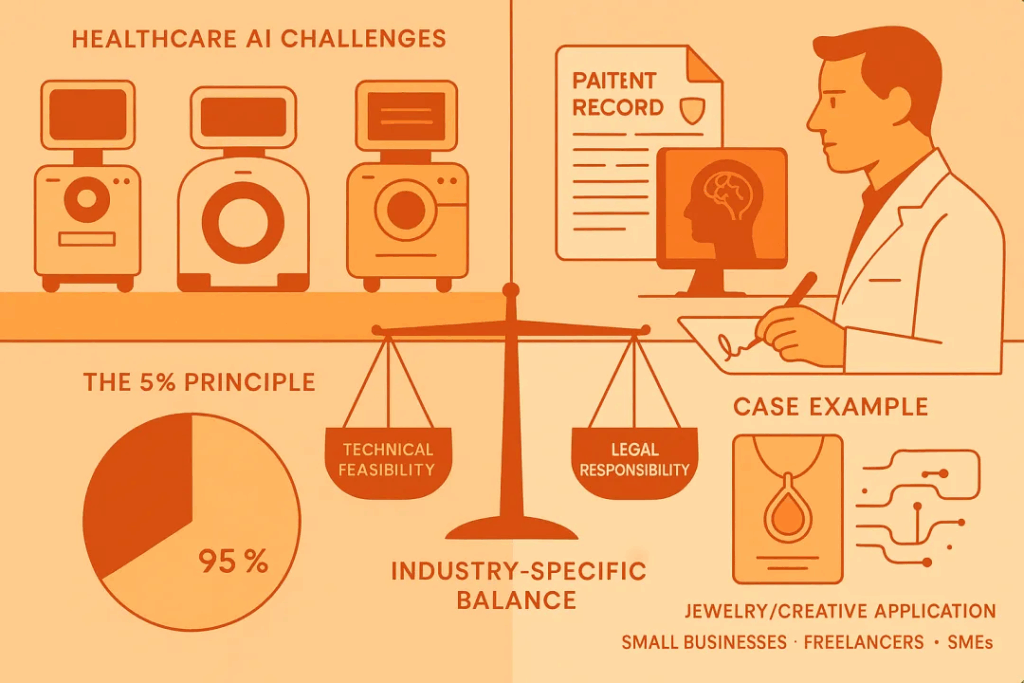
3.1 Medical AI: Balancing Technical Capability and Responsibility Boundaries
Liao Fangli shared Tencent’s collaboration with Mindray Medical to develop a vertical large model for ICUs, highlighting the three layers of complexity in industry application standardization:
Technical Layer: Different hospitals use CT machines from various brands and models, leading to differences in imaging data. Large models must account for the heterogeneity of the equipment ecosystem.
Data Layer: Medical records often reflect the personal habits of individual doctors in their documentation. Advancing the standardization of medical records is essential to improve the accuracy of large models.
Responsibility Layer: Doctors are concerned about accountability for AI misdiagnoses, as the final signature remains their responsibility. There is a significant gap between technical feasibility and legal responsibility mechanisms.
Liao Fangli (Tencent):
In specific industry scenarios, it’s not enough to consider technical feasibility and interpretability; the unique attributes of the industry itself must also be accounted for. While medical practitioners are much more receptive to AI tools than they were a few years ago.
3.2 The “5% Rule” of Standardization
The forum reached a key consensus: over-standardization can harm innovation and diversity.
Li Li (Huawei):
“In any product or service, what requires standardization accounts for less than 5% of the entire knowledge domain. The other 95% does not need it. Standardization should not exist for its own sake—innovate where innovation is needed, and standardize where standardization is required.”
Case Insight:
Liao Fangli shared the example of Shenzhen’s Shuibei jewelry industry, where AI toolchains helped create personalized workflows. For many small and medium-sized enterprises (SMEs), freelancers, and individual entrepreneurs, their needs are inherently “non-standard.” Standardization efforts must account for these economically active groups rather than forcing uniform standards upon them.
4. The Standardization Path for Ethics and Social Impact
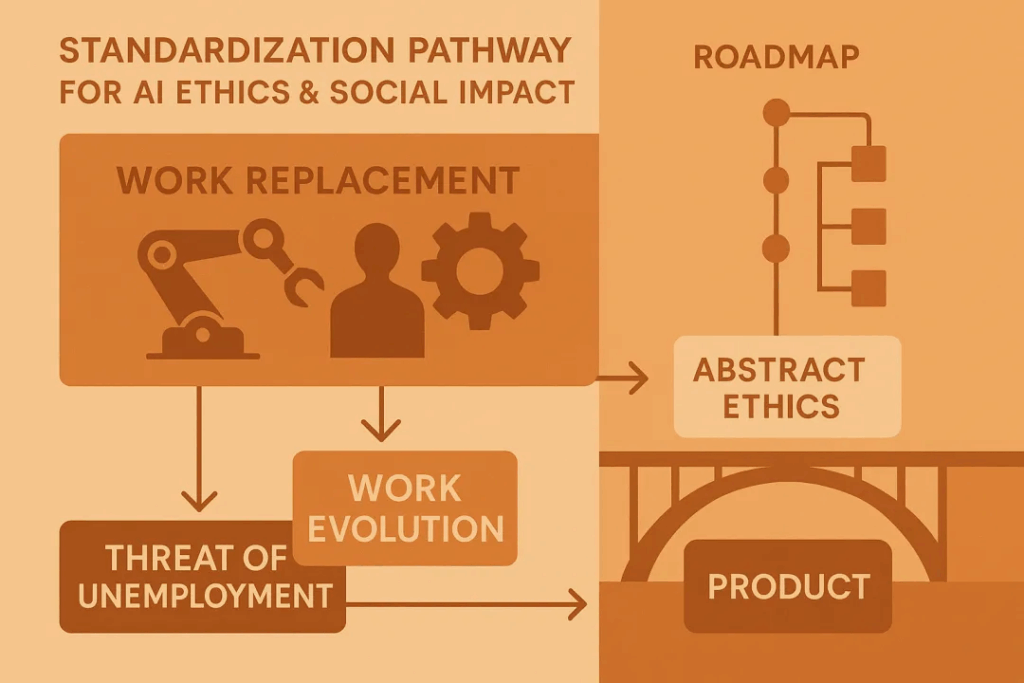
4.1 Job Replacement: The Overwhelming Ethical Issue
A real-life scenario sparked a deep discussion. During the CEIC conference, a leader noticed the professional live interpreters on-site and asked, “Why not use AI translation?” This small detail reflects the core yet hardest-to-answer question in AI ethics discussions.
Li Li (Huawei):
“I’ve reviewed many lists of AI ethical issues, and job replacement is likely the most critical one, outweighing all other ethical concerns combined. This issue involves policy-level decisions: standardization promotes the large-scale application of AI, which could lead to mass unemployment”
4.2 Shifting Perspectives: From “Unemployment Threat” to “Work Evolution”
Experts reached deeper insights into the relationship between AI and employment:
Yang Tao (Comentropy):
“In the next five years, there will undoubtedly be earth-shaking changes, and unemployment rates may rise. But this raises an ultimate philosophical question: do humans work for the sake of working, or for the sake of not working? Will humanity face extinction or prosperity as a result?”
Li Li (Huawei):
90% of jobs are highly repetitive and don’t create real value. AI can free us from these repetitive tasks and allow us to focus on more creative work. AI isn’t causing unemployment—it’s driving the evolution of how humanity works.
Chen Xi (Shanghai AI Research Institute):
“Take logistics sorting, for example. It’s a particularly monotonous job that can lead to occupational injuries. When robots replace these roles, the workers can transition to training the robots and become ‘coaches’ of embodied intelligence. “
4.3 The Practical Path to Ethical Standardization
Core Challenge: How can abstract AI ethics be translated into technical standards that can be embedded into products?
Liao Fangli (Tencent):
“When it comes to specific products, how can ethical concerns be turned into a universal standard that can be embedded into AI products? Only then can AI ethics truly be implemented. Otherwise, ethical discussions will remain just discussions forever.”
China’s Practice | Shen Zhiyue (China Electronics Standardization Institute):
- Safety Standards (Already Implemented): Released China’s first mandatory AI national standard: Network Security Technology – Artificial Intelligence-Generated Synthetic Content Identification Methods.
- Ethical Explorations:
- Established a national AI standardization governance working group, with Peking University serving as the lead.
- Published the Research Report on AI Technology Ethics and Review & Evaluation in both Chinese and English, proposing the principle of “human-centered, AI for good.”
- Core Requirement: AI development must not infringe upon any fundamental human rights.
- Next Steps:Refining the ethical review process into national standards.
5. Data Sovereignty and International Cooperation

5.1 The “Drop in the Ocean” Dilemma of Simplified Chinese Data
Liao Fangli (Tencent):
Although Simplified Chinese internet data is generated by 1.4 billion people and is massive in volume, it remains just a “drop in the ocean” compared to the global flow of data produced by 7 billion people in English. This could become the second major bottleneck after computing power.
Data Complexity Analysis | Gan Keqin (China National Institute of Standardization):
- Early large models (e.g., Llama) used 89–92% English-language training data.
- When expanding into smaller language countries, where will the necessary data come from?
- Sensitive issues arise, such as cross-border data flow, sovereignty risks, and more.
Li Li (Huawei):
“In the AI era, the challenge of English-language data is no longer a problem because AI can translate it. The core issue is extracting the semantic meaning of the information being conveyed. The real challenge lies in data flow regulation and copyright.”
5.2 Standardization to Break Through Geopolitical Barriers
Strategic Value:
During the 2025 China International Import Expo, the China Electronics Standardization Institute released foreign-language versions of national standards for large models (in English, Lao, Burmese, etc.), addressing the lack of AI model standards in ASEAN countries. This initiative creates a bridge for exporting China’s advanced AI technologies.
Li Li (Huawei):
Standards are a universal language—they are open & best tool to break through geopolitical barriers.The so-called ‘values’ differences that Western politicians emphasize are mostly empty when examined closely. When it comes to fundamental ethical and technical issues, humanity is largely aligned.
5.3 The Urgency of Domestic Coordination
Yang Tao (Comentropy):
“Coordination is crucial. In a highly sensitive domain like data, there must be a ‘national chessboard’ approach to planning. As a key factor of production, the collaboration around high-quality data is absolutely critical.”
6. Next-Generation Infrastructure: Strategic Competition in Intelligent Agent Protocols
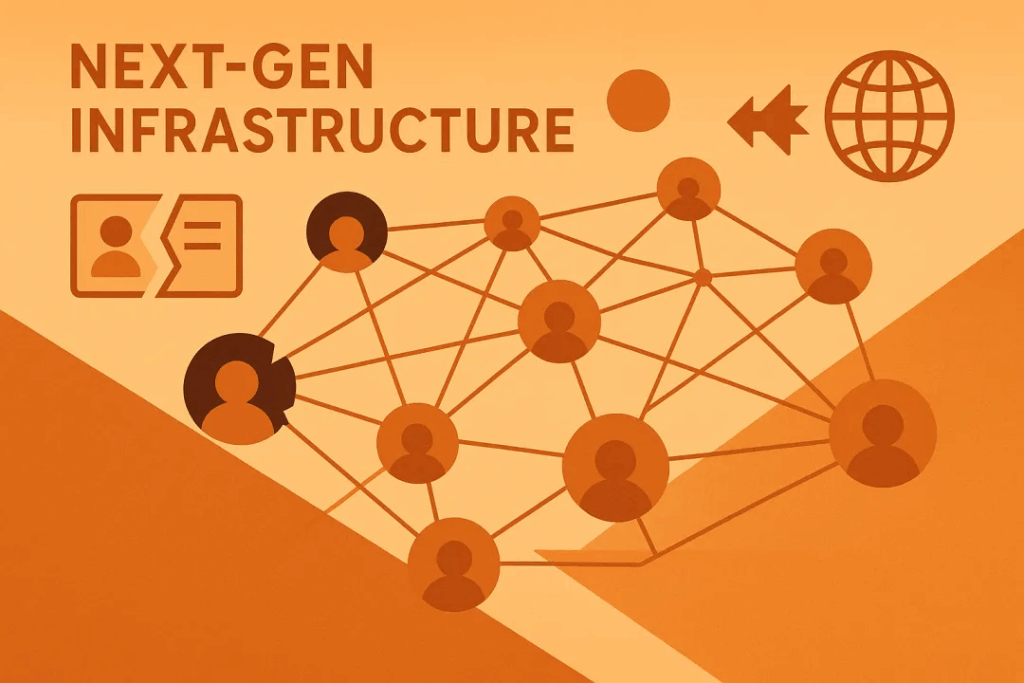
6.1 A2A Protocol: The Overlooked Precursor to “Skynet”
In 2025, Google released the A2A (Agent-to-Agent) protocol and donated it to the Linux Foundation. It is now regarded as a foundational infrastructure standard for communication between intelligent agents.
Yang Tao (Comentropy):
“The concept of ‘Skynet’ from Terminator is essentially this. A single robot is not frightening; what is truly alarming is the day when an intelligent agent network is formed. Research in this area must be accelerated, and proactive planning is essential. We are already late.”
Historical Parallel:
In the early days of the internet, there were hundreds of competing protocols, but TCP/IP eventually emerged victorious due to its elegance and openness. Similarly, the competition around intelligent agent protocols will determine who controls the discourse for the next generation of the internet.
6.2 Core Flaw: The Identity Recognition Problem
Li Li (Huawei):
Both A2A and MCP suffer from a critical flaw: they fail to solve the issue of ‘identity recognition’ for intelligent agents. China’s approach to internet governance is that ‘it can’t become a lawless zone,’ whereas U.S. technology and policy lean to decentralization and anonymity on the internet.
Technical Reference:
It is recommended to draw inspiration from the EU’s EDIR (European Digital Identity Regulation), which is an evolution of eIDAS. This well-designed framework could provide insights for creating a uniquely Chinese intelligent agent communication protocol.
6.3 China’s Standardization Strategy
Shen Zhiyue (China Electronics Standardization Institute):
“Our institute is currently leading the development of a national standard series for intelligent agent interconnectivity. This includes areas such as overall architecture, agent identity codes, identity management, agent description, discovery, and interaction.”
7. The Future Form of Standardization
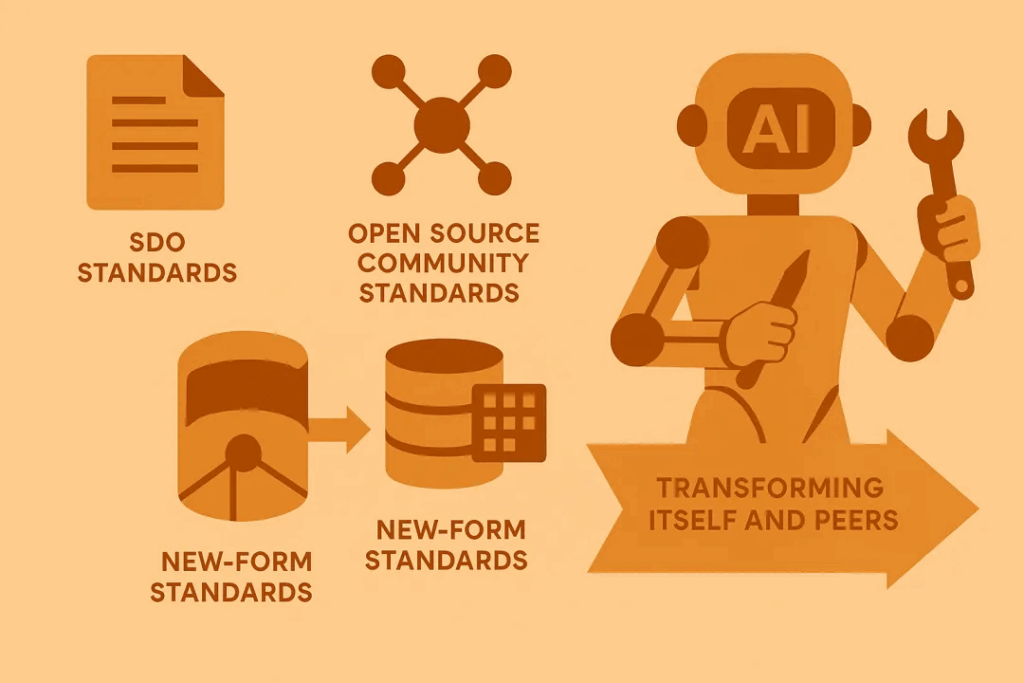
7.1 From Text Standards to Ecosystem Standards
Gan Keqin (China National Institute of Standardization):
The form of standards is evolving into three main types:
- Traditional SDO Standards: Consensus documents issued by standardization organizations.
- Open-Source Community Standards: De facto standards, such as those emerging from ecosystems like GitHub.
- New-Form Standards: Standards based on datasets, platforms, and similar innovations.
In the AI era, standardization goes beyond merely drafting standard documents—it involves building a complete ecosystem that includes standards, open source, and datasets. Only such ecosystems can effectively enable large-scale applications.
7.2 Can AI Set Standards for Itself?
Yang Tao (Comentropy):
Some leaders have asked, “Can AI create new standards?” We believe this is highly feasible. In the future, standards might no longer be written by engineers but by AI itself, or even standards created by AI for AI.
Efficiency Revolution:
- Tasks that used to take engineers two weeks to complete can now be finished by AI in 20 minutes.
- Experts who haven’t written code for over 20 years, with the help of AI and engineers setting up an environment in one hour, can write website code within five minutes.
7.3 The Standardization Path of “Transforming Ourselves and Our Peers”
Gan Keqin (China National Institute of Standardization):
The path for AI-enabled standardization at the China National Institute of Standardization involves:
- Transforming Ourselves: Addressing challenges in the digitalization of standards, such as accurate OCR, knowledge graph construction, and the extraction of standard indicators. Large models have simplified previously complex tasks.
- Transforming Our Peers: Sharing best practices with similar institutions to create replicable solutions.
- Expanding to Related Fields: Fields such as scientific literature and patents also face similar challenges in knowledge graph construction, where this methodology can be applied.
Standardization doesn’t always need to be mandatory with a “you must do it this way” approach. Instead, the diffusion of best practices can be encouraged. When strong requirements for ethics, safety, or similar concerns arise, stricter standard constraints can be applied.
8. Key Findings and Strategic Reflections
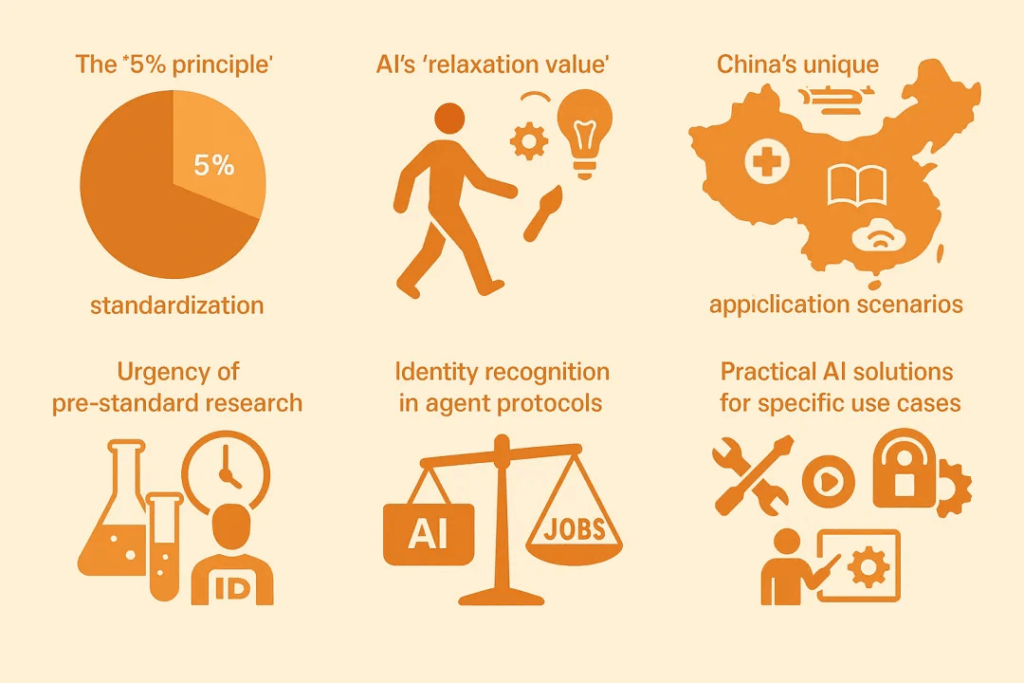
8.1 Seven Core Insights
1. The “5% Rule” of Standardization
Only 5% of areas truly require standardization, while 95% should preserve room for innovation. The original intent of standardization is to enable the large-scale application of best practices, not to pursue standardization for its own sake.
2. The Value of AI’s “Sense of Relief”
AI liberates us from repetitive tasks, creating a “sense of relief” that allows us to focus on creative work. This is not a threat but an evolution of how humans work.
3. Scenario as China’s Core Advantage
The diverse application scenarios generated by China’s 1.4 billion people are the country’s most unique advantage in AI development—an edge unmatched by the U.S.’s computing power or Europe’s governance frameworks.
4. Work Replacement as the Overwhelming Ethical Issue
Among all ethical issues in AI, the replacement of human labor outweighs all others combined. This represents a fundamental transformation in production relationships, requiring top-level design at the national level.
5. Pre-Standard Research is Urgent
Technical breakthroughs must be accompanied by pre-standard research. Without this synchronization, even with technical leadership, China risks losing control over ecosystems and markets.
6. Identity Recognition is Key for Intelligent Agent Protocols
Protocols like A2A (Agent-to-Agent) suffer from a critical flaw: unresolved identity recognition. If China can overcome this, it will gain a competitive edge in next-generation internet infrastructure.
7. China’s AI Path Should Prioritize Pragmatic Applications
China should resist being swayed by the U.S.’s capital-driven, heavy-asset model. True AI should be democratized, focusing on solving real-world problems in specific scenarios rather than blindly pursuing AGI (Artificial General Intelligence).
8.2 Emerging Strategic Directions from the Discussions
Based on the experts’ in-depth conversations, the following strategic directions merit continued attention:
Cross-Ministerial Coordination Mechanism
Break down data silos and overcome institutional barriers by establishing a nationwide, unified data coordination mechanism. This would enable top-level design for AI standardization and ethical governance.
Standards for Intelligent Agent Communication
Address the bottleneck of identity recognition in protocols like A2A and MCP (Multi-Agent Communication Protocols). Drawing inspiration from the EU’s eIDAS regulation, China should develop standards aligned with its internet governance requirements and actively promote its solutions in international standards organizations.
Pre-Standard Research Synchronization
Synchronize technical R&D with pre-standard research to avoid the strategic risk of “technical breakthroughs without standardization, leading to lost ecosystems.” Strengthen the publication of standards in foreign languages to use standards as a bridge for technological diplomacy and global industry expansion.
Quantifiable Ethical Standards
Transform ethical review methods into concrete technical standards by establishing quantifiable ethical evaluation metrics that can be embedded in products. Foster consensus among academia, industry, research institutions, and policymakers on ethical standardization.
Refinement of Application Scenarios
Avoid the heavy-asset investment of the U.S. and the overregulation of Europe by distilling standards from the practical needs of industries. Adhere to a dynamic standardization approach of “exploring, applying, identifying issues, and accumulating experience.”
Synergistic Ecosystem Collaboration
Leverage the advantages of neutral third-party organizations in top-level design and domain coordination of standard systems. Promote the exploration of new types of standards in areas such as open-source communities and datasets. Build an open discussion platform for multi-stakeholder participation, including academia, industry, research, and government.
9. Conclusion

9.1 Finding Certainty in Uncertainty
This roundtable discussion reached significant consensus on the “super-complex proposition” of AI standardization: Standardization in the AI era should not be a rigid, top-down set of rules. Instead, it should be a dynamic process of simultaneous exploration, application, problem-solving, and experience accumulation. It requires a delicate balance between innovation and regulation, openness and security, globalization and localization.
China’s opportunities lie in three unique advantages:
- The Most Diverse Application Scenarios: The multifaceted needs of 1.4 billion people.
- The Most Pragmatic Development Path: A scenario-driven approach instead of capital-driven strategies.
- The Most Open Cooperative Posture: Using standards to break through geopolitical barriers.
Li Li’s Summary:
“If China can strike the right balance between the 5% that needs standardization and the 95% that requires innovation, it could carve out a third path that is both efficient and inclusive, innovative yet controllable, oriented toward the future while safeguarding human well-being.”
9.2 The Dialectic of Anxiety and Hope
The most candid moment of the forum came when Yang Tao openly shared his sense of anxiety:
Yang Tao (Comentropy):
I worry that by accelerating the discussion on standardization, we are inadvertently accelerating AI development, which could lead to unemployment and uncertainty for humanity. It’s precisely the sense of anxiety that drives us to seriously reflect on the relationship between technology and society.
Li Li responded with a more optimistic perspective:
Li Li (Huawei):
“The sense of relief that AI brings is valuable—it facilitates the evolution of humanity itself. Once freed from daily operations, everyone has the opportunity to develop decision-making abilities and strategic thinking. The future is undoubtedly bright, so don’t be anxious.”
Ultimately, these two perspectives converged into a shared consensus: while the future is fraught with uncertainty, the direction is becoming increasingly clear. This is not blind technological optimism but a rational judgment based on China’s unique strengths.
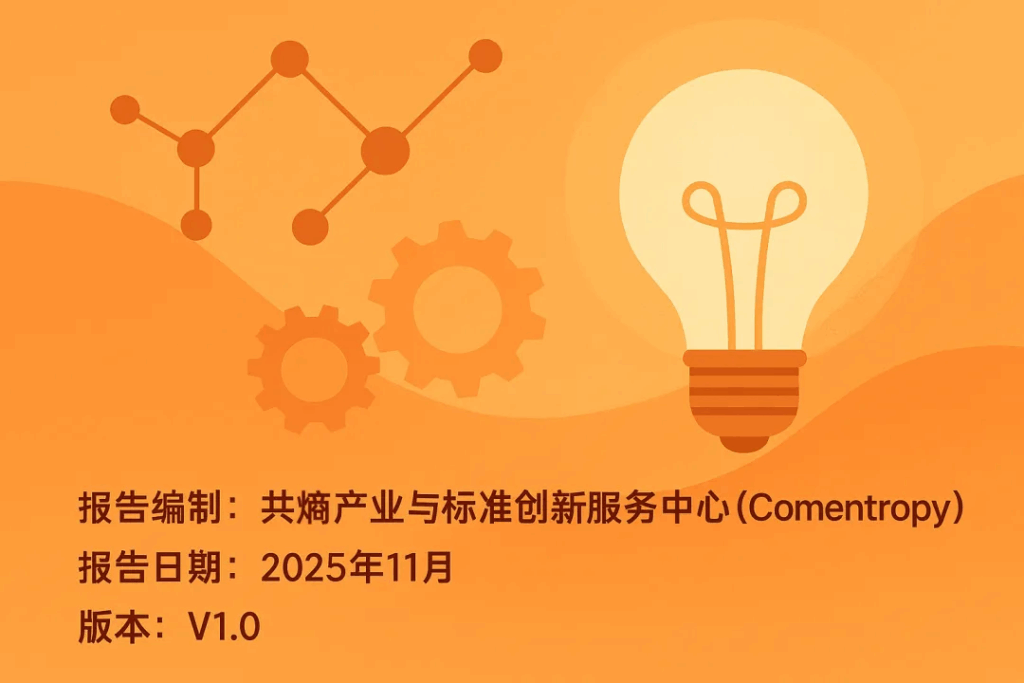
This report is copyrighted by the 2025 CEIC Organizing Committee and the Comentropy Industry and Standards Innovation Service Center. Quotation and dissemination are welcome, provided the source is properly credited.

feel free to scan the QR code
to join the “Comentropy Family”
and work together
to advance industry and standards!
